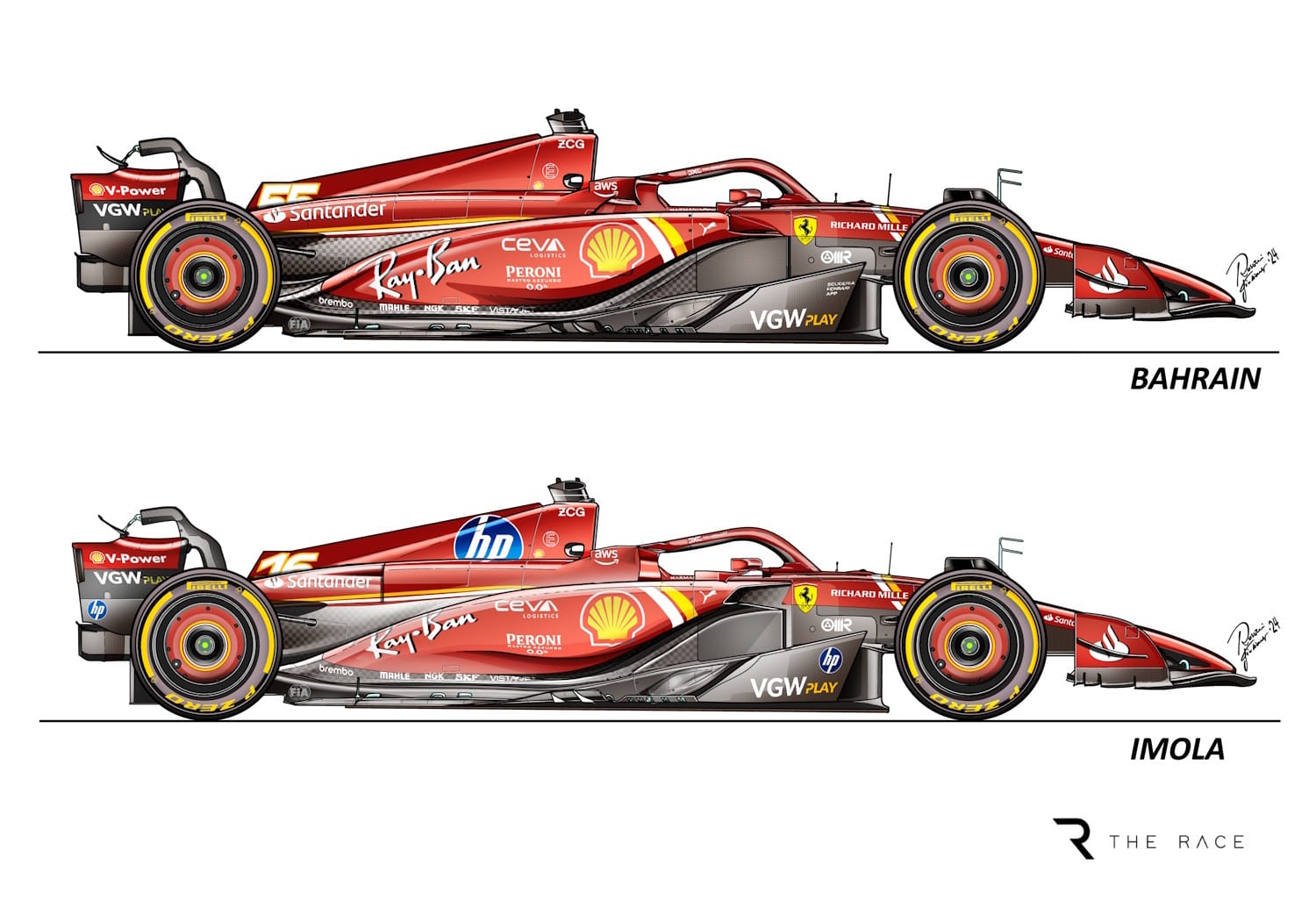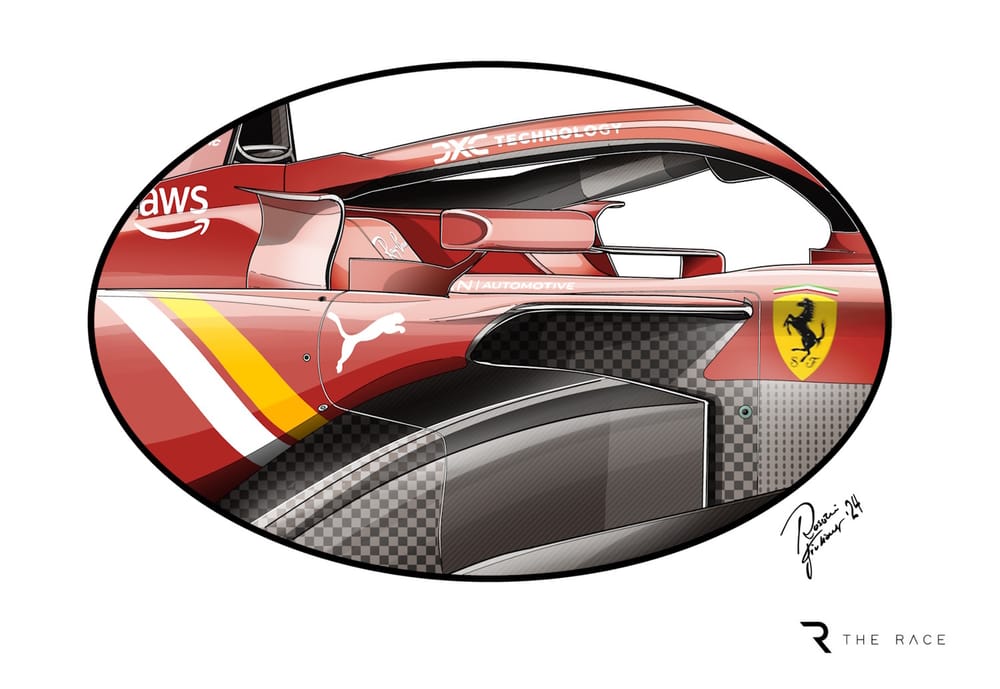Up Next

My first reaction on seeing the initial images of Ferrari’s Imola upgrade package leaking out from the team’s recent Fiorano Formula 1 test was that the update was fairly limited.
But now, seeing more pictures from the Imola paddock, it does appear to be a comprehensive package that - if Ferrari can get it all working - should bring a reasonable step in performance.
FRONT WING
It’s interesting to see at the outboard end of the front wing flap assembly (magenta arrow above), which is where it all reduces in camber and overall cord length, that Ferrari has such a long cord main plane (which I have highlighted on the other side with a green arrow).
I’m pretty sure this works in conjunction with the detail I have highlighted with the green ellipse (above). This is a continuation of the outer flap but it opens up the endplate gap to the tyre, resulting in increased outwash - though it is questionable as to what level of outwash is acceptable.
RADIATOR INLET
The most significant change is to the radiator inlet. In this comparison from old to new we can see Ferrari has definitely taken inspiration from what Red Bull introduced at the beginning of 2024.
Ferrari has always had the vertical inlet (highlighted with the vertical green line) and it has been suspected this was connected to the outlet duct at the side of the cockpit, forming what is loosely called an ‘S-duct’ to bleed off the boundary layer that builds up on the side of the chassis. Now that appears to be incorporated in the actual cooling inlet duct.
By doing this, Ferrari has been able to more or less keep the inlet volume (highlighted with the yellow arrows) as before - but raise the lower surface to improve the mass flow (highlighted by the blue arrows) through the undercut on the front corner of the sidepod.
The flow coming off the trailing edge of the front wing will now have less effect on the cooling so may allow Ferrari to run closer to the cooling limit that the power unit package requires.
'S-DUCT' OUTLET
This was the outlet of what was called the ‘S-duct’. It helped to reduce the boundary layer build-up on the side of the chassis but the exit flow (highlighted with the blue arrows) from that duct would be fairly beaten up so not much energy left in it.
Ferrari also had this turning vane to help with the scavenging of airflow from that ‘S’ duct, but together with the highlighted green arrows this flow would probably have had a reasonable negative effect on the overall upper body surface flow structure.
Now Ferrari has been able to concentrate on optimising this flow structure along the sides of the cockpit side with a new turning vane (magenta ellipse).
UPPER COOLING EXIT
Further downstream Ferrari has altered the position of the upper cooling exit - moving it further rearward.
It is also ‘larger’; the sizing of this style of exit can be difficult, and you need to make sure that you simulate the radiator flow exactly otherwise when the radiator starts to block off it can lead to reverse flow (which I have highlighted with green arrows above).
If this happens it can lead to all sorts of strange airflow problems. An array of louvres, which can be altered to suit the cooling requirements, can be a better way of managing this exit flow.
SUBTLE BUT VITAL FLOOR TWEAK
Ferrari has also opened up this small inlet duct (highlighted with the yellow arrows) on the rear section of the floor. This will connect up to the airflow that is forced inside the tyre as it rotates onto the track surface (green arrows).
This flow around the tyre contact patch gets pulled into the void where the rear tyre comes away from the ground behind the contact patch - basically working like a vacuum cleaner, so helping seal the underfloor. It can also give reasonable drag reduction.
DRAMATIC 'SKI RAMP'
We often talk about the ‘ski ramp’ sidepod. This one I have highlighted with the blue arrow is fairly dramatic and gets flow down into the central part of the diffuser but also improves the effectiveness of the so-called 'coke bottle' area where the bodywork narrows, pulling more flow away from the front face of the tyre.
It’s interesting how simple and brutal the pullrod adjuster is (highlighted in green). In these ground effect days, which carry a major risk of porpoising, it's all about being able to optimise the rear ride height quickly and easily - if you have something too complicated you will never get the best from your package.
REAR WING DETAILING
The detail on the outer end of the rear wing main plane and upper flap (which I have highlighted with the yellow ellipse) is impressive.
This is all about reducing the vortices that are set up by the pressure differences across the wing and endplate surfaces in this area.
We used to see huge rooster tails in damp conditions. They are still there but much reduced.
AN IMPRESSIVE PACKAGE

I’m sure there are more developments from the area that really matters - the underfloor - but from what we have had the pleasure of seeing I’m impressed.
That doesn’t mean it will all work immediately this weekend, but Ferrari has done a filming day to check correlation. And, after all, Imola is just a stone’s throw from Maranello - so the team will be burning the midnight oil with simulation to get the best from it.



